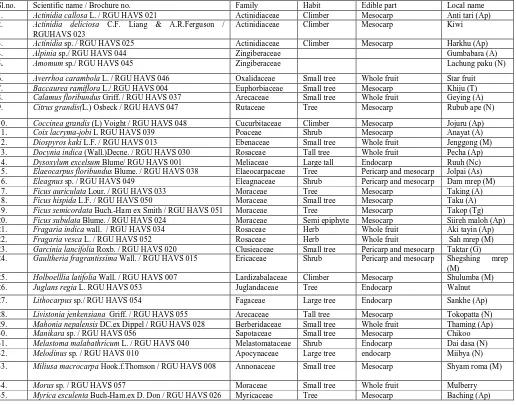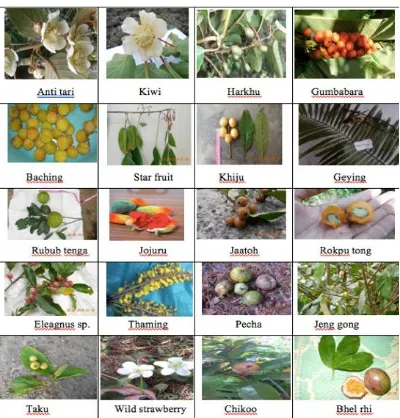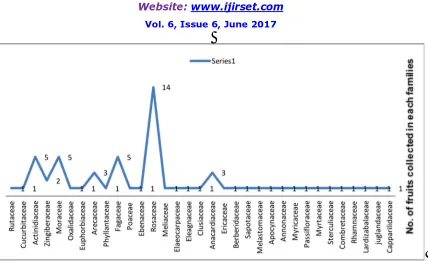ISSN(Online): 2319-8753 ISSN (Print): 2347-6710
I
nternational
J
ournal of
I
nnovative
R
esearch in
S
cience,
E
ngineering and
T
echnology
(An ISO 3297: 2007 Certified Organization)
Website: www.ijirset.com
Vol. 6, Issue 6, June 2017
Wild Edible Fruits of Arunachal Pradesh
Ayam Victor Singh1, Hage Asha2
Assistant Professor, Department of Botany, RG University, Rono Hills, Arunachal Pradesh, India1
PhD Student, Department of Botany, RG University, Rono Hills, Arunachal Pradesh, India2
ABSTRACT
:
Arunachal Pradesh is the home to a diverse range of fruits. These fruits have been the important part ofdietary supplement and at times were used for curing certain diseases and were preserved in sacred places since time immemorial. Some of them are still underutilized and unexplored. This paper tries to highlight the diversity of fruits with their uses in the five districts of Arunachal Pradesh viz. Lower Subansiri, Lower Dibang Valley, Upper Subansiri, Kra Daadi and West Siang. A total of 63 species were identified with the highest species under Rosaceae during the study. Nineteen species were locally very popular with higher market value in comparison to the rest which were lesser known. Actinidia deliciosa C.F. Liang & A.R.Ferguson, Prunus domestica L., Prunus cerasoides D.Don and a Pyrus sp. were used for preparing beverage. Candies were also prepared from a Pyrus sp. Fruits such as Mahonia nepalensis DC.,
Dillenia indica L, Terminalia chebula Retz., Ziziphus maurutiana Lam., Pyrus sp. and Averrhoa corombola L. had
medicinal value. A certain fruit from Daporijo, known as “Takok” (Moraceae) in Tagin language was known to have contraceptive value. Trees of Mahonia nepalensis DC., Quercus sp., Prunus persica L. and Prunus domestica L. are found in the sacred groves and considered sacred by the Apatani tribes; neither the fruits of these groves are allowed to be consumed nor the tress allowed to be felled due to the belief that the deity resides in them.
KEYWORDS:Arunacahal Pradesh, Fruit Diversity, Major fruits, Preparing beverage, Underutilized
I. INTRODUCTION
Fruits are the seed-bearing structure of plants which may or may not be edible. Edible fruits have been consumed by humans since time immemorial and are important part of the diet for a healthy living. Some of the wild fruits have even become important part of the culture in some indigenous people’s tradition and are known to be effective against certain diseases thus getting popular and commercialized into various products (Prakash et al., 2012). Fruits may be consumed raw or processed into jellies, jams and pickles (Sundriyal and Sundriyal, 2001; Glew et al., 2005). Also, selling of wild fruits act as a source of income for the people living in remote area (Sanjib B et al., 2013).However, with the increasing anthropogenic activities due to population expansion and natural calamities in the state several wild, semi wild, minor and less known fruits have become vulnerable to existence. Therefore, it calls for the urgent need of exploring and popularizing and the awareness for their importance. The following was an attempt to showcase the various wild fruits found in some of the districts of Arunachal Pradesh.
II. MATERIALS AND MATHODS
Study area
ISSN(Online): 2319-8753 ISSN (Print): 2347-6710
I
nternational
J
ournal of
I
nnovative
R
esearch in
S
cience,
E
ngineering and
T
echnology
(An ISO 3297: 2007 Certified Organization)
Website: www.ijirset.com
Vol. 6, Issue 6, June 2017
Field Collection and Identification
ISSN(Online): 2319-8753 ISSN (Print): 2347-6710
I
nternational
J
ournal of
I
nnovative
R
esearch in
S
cience,
E
ngineering and
T
echnology
(An ISO 3297: 2007 Certified Organization)
Website: www.ijirset.com
Vol. 6, Issue 6, June 2017
The plant specimens were pressed and herbarium voucher specimens were prepared following chemical sterilization and identification were done referring to literatures and “Flora of British India” and referring to specimens in Botanical Survey of India (BSI, Shillong and Itanagarh) and classified following Bentham and Hooker’s system of classification.
III. RESULT
A total of 63 fruits were reported belonging to 33 families (Table 1). The family Rosaceae accounted for the highest number (14 species) (Fig. 2). The present collection comprises of fruits in semi-wild and wild conditions. Twelve species are found to be common and popular in the market. Some of the fruits collected during the study which were sold in the local vendors are Actinidia deliciosa C.F. Liang & A.R. Ferguson, Averrhoa carambola L., Baccaurea
ramiflora L., Phyllantus emblica L., Citrus grandis (L.) Osbeck., Dillenia indica L, Docynia indica (Wall.) Decne.,
Elaeocarpus floribundus Blume., Juglans regia L., Myrica esculenta Buch-Ham.ex D. Don., Prunus nepalensis Koch.,
Dysoxylum excelsum Blume, Prunus persica (L.) Batsch, Prunus salicina Lindl., Pyrus communis Lin., Spondias sp.,
Terminalia chebula Retz., Zizyphus mauritiana Lam. The photographs of some of the collection were shown in Fig. 3.
Table 1.: List of fruits collected from the districts of Arunachal Pradesh
Sl.no. Scientific name / Brochure no. Family Habit Edible part Local name
1. Actinidia callosa L. / RGU HAVS 021 Actinidiaceae Climber Mesocarp Anti tari (Ap)
2. Actinidia deliciosa C.F. Liang & A.R.Ferguson / RGUHAVS 023
Actinidiaceae Climber Mesocarp Kiwi
3. Actinidia sp. / RGU HAVS 025 Actinidiaceae Climber Mesocarp Harkhu (Ap)
4. Alpinia sp./ RGU HAVS 044 Zingiberaceae Gumbabara (A)
5. Amomum sp./ RGU HAVS 045 Zingiberaceae Lachung paku (N)
6. Averrhoa carambola L. / RGU HAVS 046 Oxalidaceae Small tree Whole fruit Star fruit
7. Baccaurea ramiflora L./ RGU HAVS 004 Euphorbiaceae Small tree Mesocarp Khiju (T)
8. Calamus floribundus Griff. / RGU HAVS 037 Arecaceae Small tree Whole fruit Geying (A)
9. Citrus grandis(L.) Osbeck / RGU HAVS 047 Rutaceae Tree Mesocarp Rubub ape (N)
10. Coccinea grandis (L) Voight / RGU HAVS 048 Cucurbitaceae Climber Mesocarp Jojuru (Ap)
11. Coix lacryma-jobi L RGU HAVS 039 Poaceae Shrub Mesocarp Anayat (A)
12. Diospyros kaki L.F. / RGU HAVS 013 Ebenaceae Small tree Whole fruit Jenggong (M)
13. Docynia indica (Wall.)Decne. / RGU HAVS 030 Rosaceae Tall tree Whole fruit Pecha (Ap)
14. Dysoxylum excelsum Blume/ RGU HAVS 001 Meliaceae Large tall Endocarp Ruuh (Nc)
15. Elaeocarpus floribundus Blume. / RGU HAVS 038 Elaeocarpaceae Tree Pericarp and mesocarp Jolpai (As)
16. Eleagnus sp. / RGU HAVS 049 Eleagnaceae Shrub Pericarp and mesocarp Dam mrep (M)
17. Ficus auriculata Lour. / RGU HAVS 033 Moraceae Tree Mesocarp Taking (A)
18. Ficus hispida L.F. / RGU HAVS 050 Moraceae Small tree Mesocarp Taku (A)
19. Ficus semicordata Buch.-Ham ex Smith / RGU HAVS 051 Moraceae Tree Mesocarp Takop (Tg)
20. Ficus subulata Blume. / RGU HAVS 024 Moraceae Semi epiphyte Mesocarp Siireh maloh (Ap)
21. Fragaria indica wall. / RGU HAVS 034 Rosaceae Herb Whole fruit Aki tayin (Ap)
22. Fragaria vesca L. / RGU HAVS 052 Rosaceae Herb Whole fruit Sah mrep (M)
23. Garcinia lancifolia Roxb. / RGU HAVS 020 Clusieaceae Small tree Pericarp and mesocarp Taktar (G) 24. Gaultheria fragrantissima Wall. / RGU HAVS 015 Ericaceae Shrub Pericarp and mesocarp Shegshing mrep
(M)
25. Holboelllia latifolia Wall. / RGU HAVS 007 Lardizabalaceae Climber Mesocarp Shulumba (M)
26. Juglans regia L. RGU HAVS 053 Juglandaceae Tree Endocarp Walnut
27. Lithocarpus sp./ RGU HAVS 054 Fagaceae Large tree Endocarp Sankhe (Ap)
28. Livistonia jenkensiana Griff. / RGU HAVS 055 Arecaceae Tall tree Mesocarp Tokopatta (N) 29. Mahonia nepalensis DC.ex Dippel / RGU HAVS 028 Berberidaceae Small tree Whole fruit Thaming (Ap)
30. Manikara sp. / RGU HAVS 056 Sapotaceae Small tree Mesocarp Chikoo
31. Melastoma malabathricum L. / RGU HAVS 040 Melastomataceae Shrub Endocarp Dai dasa (N)
32. Melodinus sp. / RGU HAVS 010 Apocynaceae Large tree endocarp Miibya (N)
33. Miliusa macrocarpa Hook.f.Thomson / RGU HAVS 008 Annonaceae Small tree Mesocarp Shyam roma (M)
34. Morus sp. / RGU HAVS 057 Moraceae Small tree Whole fruit Mulberry
ISSN(Online): 2319-8753 ISSN (Print): 2347-6710
I
nternational
J
ournal of
I
nnovative
R
esearch in
S
cience,
E
ngineering and
T
echnology
(An ISO 3297: 2007 Certified Organization)
Website: www.ijirset.com
Vol. 6, Issue 6, June 2017
36. Passiflora edulis Sims / RGU HAVS 002 Passifloraceae Climber Endocarp Bhel rhi (Nc)
37. Pegia nitida Colebr./ RGU HAVS 036 Anacardiaceae Shrub Whole fruit Eyi dorge (A)
38. Phyllantus emblica L. / RGU HAVS 058 Phyllantaceae Tree Pericarp and mesocarp Amla 39. Pinanga gracilis Blume / RGU HAVS 005 Arecaceae Small tree Pericarp and mesocarp Tachar (N)
40. Prunus cerasoides Buch-Ham. ex D.Don / RGU HAVS 018
Rosaceae Tree Pericarp and mesocarp Sembo (Ap)
41. Prunus nepalensis Koch. / RGU HAVS 041 Rosaceae Tree Pericarp and mesocarp Chod rhi (Nc)
42. Prunus persica (L.) Batsch / RGU HAVS 027 Rosaceae Tree Mesocarp Takung (Ap)
43. Prunus salicina Lindl. / RGU HAVS 029 Rosaceae Tree Pericarp and mesocarp Plum
44. Pyrus communis Lin. / RGU HAVS 059 Rosaceae Tree Pericarp and mesocarp Naspati (Ap)
45. Pyrus pashia Buch.-Ham.ex D.Don / RGU HAVS 014 Rosaceae Tree Endocarp Jaatoh (M)
46. Quercus lamellosa Sm. / RGU HAVS 060 Fagaceae Tree Endocarp Santih (Ap)
47. Quercus semecarpifolia Sm. / RGU HAVS 012 Fagaceae Tree Endocarp Pah sheng grabo
(M)
48. Quercus sp. / RGU HAVS 061 Fagaceae Tree Endocarp Kra ahi (Ap)
49. Quercus spicata Sm. / RGU HAVS 062 Fagaceae Tree Endocarp Tibeh (Ap)
50. Rhus semialata Murray / RGU HAVS 017 Anacardiaceae Tree Whole fruit Taam ahi (N)
51. Rosa sericea Lindl./ RGU HAVS 016 Rosaceae Shrub Thalamus Jamkhuyu (M)
52. Rosa suaveolens Roxb. / RGU HAVS 063 Capparilidaceae Small tree Mesocarp Rokpu tong (N)
53. Rubus calycinus Wall.ex D.Don / RGU HAVS 035 Rosaceae Herb Whole fruit Wild strawberry
54. Rubus ellipticus Sm. / RGU HAVS 041 Rosaceae Shrub Whole fruit Mipya jilyung
(Ap)
55. Rubus fairholmianus Gardn. / RGU HAVS 042 Rosaceae Shrub Whole fruit Mipya yoyu(Ap)
56. Rubus niveus Thumb. / RGU HAVS 043 Rosaceae Shrub Whole fruit Yikhe jilyung
(Ap)
57. Saurauia armata Kurz./ RGU HAVS 006 Actinidiaceae Tree Whole fruit Pupururu (N)
58. Saurauia nepaulensis Roxb. / RGU HAVS 011 Actinidiaceae Tree Endosperm Hinchi (N)
59. Spondias sp. / RGU HAVS 009 Anacardiaceae Tree Mesocarp Biiling (Ap)
60. Sterculia lanceifolia Roxb. / RGU HAVS 031 Sterculiaceae Small tree Endocarp Taklam (G)
61. Syzygium jambos (L.)Alston / RGU HAVS 032 Myrtaceae Small tree Mesocarp Adi jamun (A)
62. Terminalia chebula Retz. / RGU HAVS 003 Combretaceae Tree Pericarp and mesocarp Hilika (As)
63. Zizyphus mauritiana Lam. / RGU HAVS 019 Rhamnaceae Small tree Pericarp and mesocarp Bogori(As)
ISSN(Online): 2319-8753 ISSN (Print): 2347-6710
I
nternational
J
ournal of
I
nnovative
R
esearch in
S
cience,
E
ngineering and
T
echnology
(An ISO 3297: 2007 Certified Organization)
Website: www.ijirset.com
Vol. 6, Issue 6, June 2017
ISSN(Online): 2319-8753 ISSN (Print): 2347-6710
I
nternational
J
ournal of
I
nnovative
R
esearch in
S
cience,
E
ngineering and
T
echnology
(An ISO 3297: 2007 Certified Organization)
Website: www.ijirset.com
Vol. 6, Issue 6, June 2017
Fig. 2: Graphical representation of fruits collected in each family.
IV. DISCUSSION
Some popular fruits which have major productions were exported to the neighboring states. Those with lesser productions were found only in local markets vendors. Some of the wild berries though consume by locals were not fully exploited in the local markets. Nuts were consumed only occasionally except for the walnut. Fruits such as
Zizyphus mauritiana Lam., Elaeocarpus floribundus Blume., Averrhoa crambola L., Myrica esculenta Buch.-Ham ex
D.Don etc. were processed and preserved into pickles and were consumed as make appetizer by the locals. Apart from consuming as fruits they have ethnobotanical importance viz., Docynia indica (Wall.) Decne fruits were used for making candies by the local ladies. However, these candies were not sold normally in markets but were made on special request. Some of the raw fruit juice were found to be helpful during loose motion and local alcoholic beverages were also prepared from some of these fruits viz., Pyrus communis Lin, Prunus cerasoides Buch-Ham. ex D.Don,
Prunus salicina Lindl and Docynia indica (Wall.) Decne etc. These beverages could be standardized and introduced in
markets. Wine production from Actinidia deliciosa C.F. Liang & A.R. Ferguson has recently been considered into larger project as their production is en mass and quite popular in Ziro. The raw fruit of Prunus cerasoides Buch-Ham ex D. Don when consumed in excess cause numbness of the body. Diospyros kaki L.F. fruit has high religious value among the Monpas of Dirang. They form important ingredient of “Prasad” during important pujas like performing the final puja during completion of one’s “Lama course” or during the ritual performance for death ceremony of high ranks Lamas. They are generally served after drying in the sun. According to tradition at Ziro, during a household holy ceremony, the members of the households were not allowed to consume fruits till certain time period. It has also been noted that the trees of Mahonia nepalensis DC.ex Dippel , Prunus persica (L.) Batsch and Quercus sp., constitute important trees of sacred grooves in Ziro. Their fruits were forbidden from consuming due to the belief that deity resides in them. During the days of “Myoko” festival, these grooves are visited by the clans to apply rice powder paste to their stem as an offering and seek to protect them from ill health. According to one informant from Daporijo, “Takop” (Ficus semicordata Buch.-Ham ex Smith) has got contraceptive value. Hence women are forbidden to consume these fruits and only men are allowed. Other parts of these plants has got other uses as well, such as the bark
of Mahonia nepalensis DC.ex Dippel was useful for curing wounds, tender leaves of Passiflora edulis Sims. were
ISSN(Online): 2319-8753 ISSN (Print): 2347-6710
I
nternational
J
ournal of
I
nnovative
R
esearch in
S
cience,
E
ngineering and
T
echnology
(An ISO 3297: 2007 Certified Organization)
Website: www.ijirset.com
Vol. 6, Issue 6, June 2017
V. CONCLUSION
Arunachal Pradesh has vast collection of diverse fruits. Each of them has their own specialty either as an important source of nutrition or as having high medicinal value. Antioxidant study was reported from Zizyphus marutiana Lam. (Bhuiyan et al, 2009), Myrica esculenta Buch-Ham.ex D. Don (Seal, 2011) and Baccaurea ramiflora Lour. (Prakash et al., 2012). Garcinia lancifolia Roxb.fruits was reported as antimicrobial and useful for treating dysentery and diarrhea (Chowdhury and Handique, 2012). The fruits of Averrhoa carambola L., has been reported to be effective against jaundice (Sarmah, 2005). Tag and Das (2006) has reported Terminalia chebula Retz. as useful against cough, chest and stomach pain. More study still needs to be done on exploring the lesser known fruits. Some of the wild and semi wild fruits, could be cultivated and commercialized to a larger extend and more awareness of the existing fruit diversity and their importance need to be spread making them understand the potential of these fruits.
VI. ACKNOWLEDGEMENT
The authors are thankful to all the local administrator, the local respondents who took active participation during the interview and for their local guidance, we also thank the BSI – Itanagar and Shillong for identification of herbaria.
REFERENCES
1.Bhuiyan, M.A.R., Hoque, M.Z. and Hossain, S.J., “Free Radical Scavenging Activities of Zizyphus mauritiana. World Journal of Agricultural Sciences”, Vol 5 (3), pp.318-322, 2009.
2.Chowdhury, T. and Handique, P.J., “Evaluation of Antibacterial activity and phytochemical activity of Garcinia lancifolia Roxb. International Journal of pharmaceutical sciences and research”, Vol 3(6), pp-1663-1667, 2012.
3.Das, A.K. and Tag, H., “Ethnomedicinal studies of the Khamti tribe of Arunachal Pradesh. Indian Journal of Traditional Knowledge”, Vol 5(3), pp317-322, 2006.
4.DoFE, “Forest statics of Arunachal Pradesh”, Department of Environment and Forests, Govt. of Arunachal Pradesh, Itanagar, 2005.
5.Glew, R.S., Dorothy, J., Chuang, L.T., Huang, Y.S., Millson, M. and Glew, R.H., “Nutrient content of four edible wild plants from West Africa”. Plant Foods for Human Nutrition, Vol 60, pp187-193, 2005.
6.Jain, S.K., Rao, R.R., “A Handbook of Field and Herbarium Technique. Today and Tomorrow Publication”, New Delhi, 1977. 7.Jain, S.K., “A manual of Ethnobotany”. Scientific Publishers, Jodhpur. 1987.
8.Prakash, D., Upadhyay, G., Gupta, C., Pushpangadan, P. and Singh, K. K., “Antioxidant and free radical scavenging activities of some promising wild edible fruits”. International Food Research Journal, Vol.19 (3), pp1109-1116, (2012).
9.Sanjib, B., Hwiyang, N. and Sanjay, B., “Wild edible fruits of Kokrajhar district of Assam, North-East India”. Asian Journal of Plant Science and Research, Vol 3(6), pp95-100, 2012.
10. Sarmah, R., “Non-Timber Forest Products and their utilization pattern in Changlang district of Arunachal Pradesh”, PhD thesis submitted to Rajiv Gandhi University, Rono Hills, Doimukh for award of degree of Doctor of Philosophy in Botany. Unpublished.
11. Seal, T., “Antioxidant Activity of Some Wild Edible Fruits of Meghalaya State in India”, Advances in Biological Research, Vol 5 (3), 155-160, 2011.


